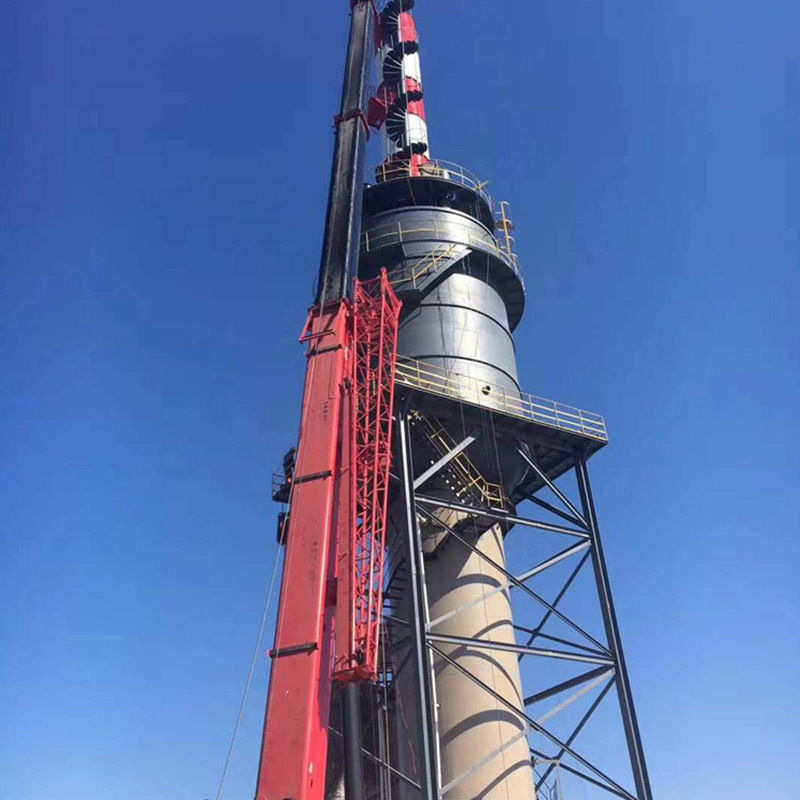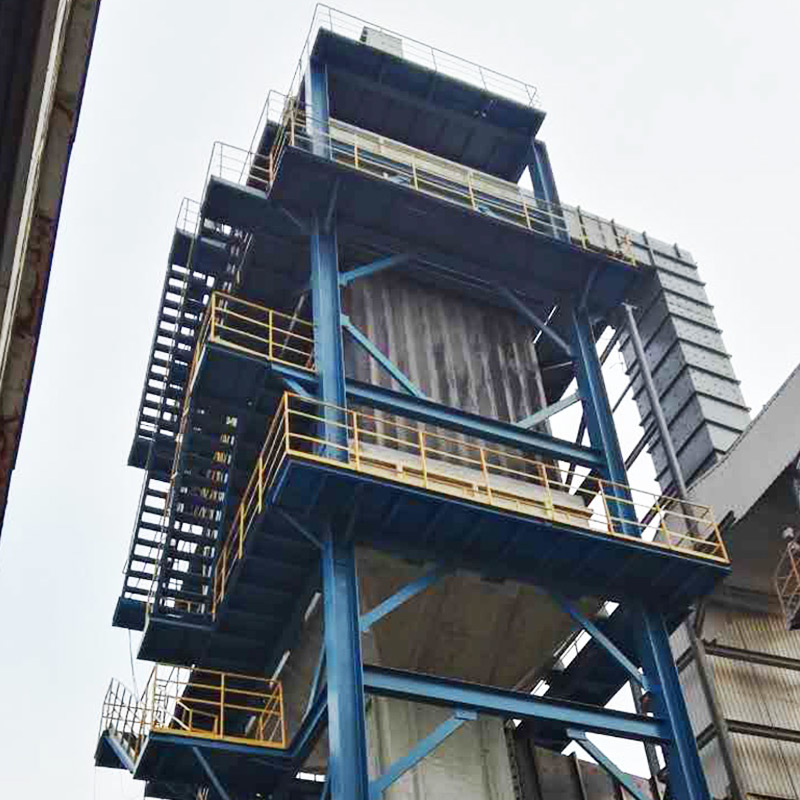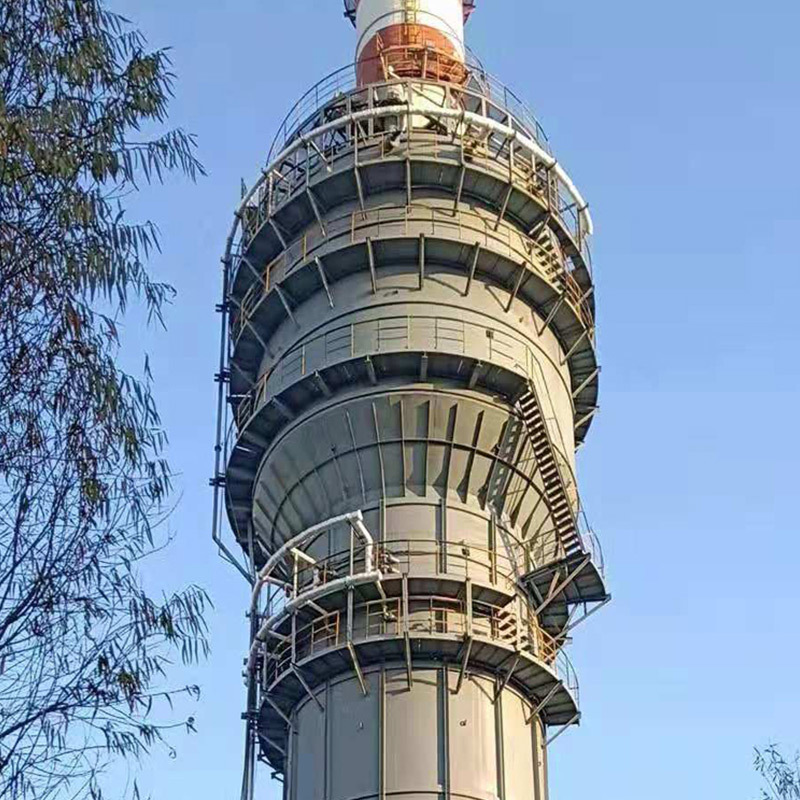
Control PM emissions
- Commodity name: Control PM emissions
- Detailed description
-
Wet electrostatic precipitator refers to an electrostatic precipitator that uses water to remove dust adsorbed on electrodes. Wet electrostatic precipitator is mainly used in the power industry to remove harmful substances such as dust and acid mist from the wet gas after desulfurization tower, and is a precision treatment environmental protection equipment for controlling atmospheric pollutant emissions from thermal power plants.
According to layout: divided into integrated and split types According to structural form: divided into vertical and horizontal types
According to the different types of electrode plates, they can be divided into plate type and tube type
According to the different types of anodes, they can be divided into three categories: metal plate wet electrostatic precipitator, conductive fiberglass wet electrostatic precipitator, and flexible plate wet electrostatic precipitator
Perhaps everyone has encountered this situation before: when we are cleaning the electrode plate (anode)
It is very difficult to clean the dust between the electrode plate or cathode plate, so we need to use a specific new product equipment - wet electrostatic precipitator. This device can effectively and quickly remove dust. This new type of equipment has developed rapidly not only because it can remove dust between the plates, but also because wet electrostatic precipitators have many advantages.What is a Wet Electrostatic Precipitator
The so-called wet electrostatic precipitator is an electrostatic precipitator that uses water spray or overflow water to form a layer of water film on the surface of the dust collecting electrode to achieve plate cleaning. Wet cleaning can avoid the re flying of settled dust and achieve high dust removal efficiency.
The cathode wire is fixed at the center of the dust collection electrode tube, and is externally connected to a high-voltage power supply. The high-voltage power supply is introduced into the cathode wire through an insulator chamber. The shell is equipped with an insulation sealing sleeve, which is also used to fix the dust collection electrode tube at both ends. The dust collection electrode tube is fixed inside the shell, and the interior of the dust collection electrode tube is covered with fiber cloth for achieving uniform water film distribution. A water distributor for achieving uniform water film distribution is installed at the upper end of the dust collection electrode tube; The lower part of the shell is equipped with a smoke inlet and a sewage outlet, and the upper part of the shell is equipped with a smoke outlet. The dust collection electrode tube is a conductive fiberglass anode tube. The cross-section of the dust collection electrode tube is a rounded regular hexagon, and it is arranged in a honeycomb pattern inside the shell, which can ensure the uniformity of water flow on the dust collection electrode plate, the reliability of cathode wire discharge, the corrosion resistance of the dust collection electrode tube, and the efficiency and stability of flushing and operation, thereby improving the dust removal effect.
There must be a reason why every product can develop, just like the seven advantages of wet electrostatic precipitators:
Advantage 1: High efficiency in removing fine particles.
Advantage 2: Simple structure, reasonable layout, easy operation, small footprint, internal anti-corrosion adopts acid resistant and wear-resistant adhesive lining technology, strong chemical stability, good thermal stability, and long service life.
Advantage 3: The dust collector has a three-stage dehydration device inside, which thoroughly separates gas and water, and the fan does not carry water. Dust removal, desulfurization, and acid removal are synchronized, with no scaling or blockage issues, and the washing water is recycled for low operating costs.
Advantage 4: There is no secondary dust, and the dust concentration at the outlet can be lower than 5mg/Nm ³.
Advantage 5: Due to the lack of rotating parts like hammering equipment, high reliability.
Advantage 6: It can effectively collect sulfuric acid aerosols and submicron particles in flue gas.
Advantage 7: Dust collection performance is independent of dust characteristics and can effectively collect high viscosity or high specific resistance dust. It is also suitable for handling high-temperature and high humidity flue gas, reducing the possibility of fire and explosion. Its filtration efficiency can reach over 95%.
You can rest assured to purchase the wet electrostatic precipitator produced by Kelin Environmental Protection, or you can visit our home for on-site inspection.
Wet electrostatic precipitator, which uses water spray or overflow water to form a water film on the surface of the dust collecting electrode, achieving electrostatic precipitator for plate cleaning. Wet cleaning can avoid the re flying of settled dust and achieve high dust removal efficiency. Compared with other dust removal equipment, electrostatic precipitators consume less energy and have higher dust removal efficiency. They are suitable for removing dust of 0.01-50mm in flue gas and can be used in situations with high flue gas temperature and pressure. Practice has shown that the larger the amount of flue gas processed, the more economical the investment and operating costs of using electrostatic precipitators.
Electric demister is a gas-liquid separation wet equipment with low fluid resistance, which can be used for acid production from smelting flue gas, tail gas treatment from titanium dioxide calcination, and various acid mist treatment in chemical plants. Electric demisters are commonly used in industries such as sulfuric acid. Electric demisters are generally vertical structures, mainly composed of corona electrode devices, anode devices, upper and lower chambers, and power supply systems.
The electrostatic defogger has the following advantages: (1) high defogging efficiency; (2) Stable performance.
Advantages of Wet Dust Collector
1. When consuming the same amount of energy and time, the efficiency of wet dust collectors is higher than that of dry dust collectors. High energy wet dust collectors wash dust particles below 5mg/m ³, and the dust removal efficiency is still very high.
2. The dust removal efficiency of wet dust collectors is not only comparable to bag filters and electrostatic precipitators, but also suitable for dust removal conditions that these dust collectors cannot handle. Wet dust collectors have high exhaust gas treatment efficiency for purifying high specific resistance, high humidity, high temperature, flammable and explosive dust containing gases.
The Concept of Wet Electrostatic Precipitator
Wet electrostatic precipitator is used to eliminate harmful substances such as micro particles in the air that are harmful to human health. Simply put, wet electrostatic precipitator can purify polluted gases in the atmosphere. After being charged, harmful substances in the air are collected and finally cleaned to ensure air quality and personal safety. Wet electrostatic precipitators can be roughly divided into two categories based on their structural form: one is the dust collector made of conductive materials with good corrosion resistance, and the other is the dust collector made of non-conductive metal materials formed by spraying water to form a conductive water film. According to the flow direction of the exhaust gas, it can be divided into cross flow wet electrostatic precipitators and longitudinal flow wet electrostatic precipitators. Normally, longitudinal wet electrostatic precipitators have much higher efficiency than transverse ones. Harmful substances on the dust collector plates of the dust collector are maliciously washed with clean water, which requires less water and is more convenient, saving water resources to a certain extent. Compared with thousand type dust collectors, wet electrostatic precipitators avoid dust from flying back into the air. Forming secondary pollution.
Wet electrostatic precipitators have the advantages of high dust removal efficiency, low pressure loss, simple operation, low energy consumption, no moving parts, no secondary dust, low maintenance costs, short production downtime, can work below the dew point temperature of flue gas, can be combined with other flue gas treatment equipment due to their compact structure, and diverse design forms. Its dust removal efficiency reaches over 99.9%, which can achieve ultra-low emissions and is an ideal equipment for controlling atmospheric dust pollution.Advantages of Wet Electrostatic Precipitator for Dust Cleaning
Cleaning dust can avoid the re flying of captured dust and achieve high dust removal efficiency. Due to the absence of a vibration device, the operation is also relatively reliable. The device that uses water spray or overflow to form a conductive film on the surface of the dust collection electrode has problems with corrosion, sludge and sewage treatment, and is only used when the gas dust concentration is low and high dust efficiency is required; The wet electrostatic precipitator using corrosion-resistant conductive materials as the dust collector does not require long-term water spraying or overflow water. It only needs to be regularly flushed according to the system's operating conditions, consuming only a very small amount of water. This water can be recycled and reused, and the dust collection system has basically no secondary pollution.Dust Removal Principle of Wet Electrostatic Precipitator
This device charges dust through high-voltage corona discharge, and the charged dust reaches the dust collection plate/tube under the action of electric field force. This device mainly processes wet gases with high or even saturated water content. There is a significant difference between WESP and DESP in the way dust is removed from the collection plate/tube, while wet electrostatic precipitators use regular flushing to remove dust with the flow of flushing solution.
Technical Characteristics of Wet Electrostatic Precipitator
1. The anode is made of CF superconducting composite material and equipped with a dedicated cathode system, with a dust removal efficiency of over 99.9% and an outlet smoke concentration of le; 1~5mg/Nm ³.
2. Excellent corrosion resistance and long service life. The first one was used for flue gas treatment in 1993 and has been running very stably ever since, with all components intact as before.
3. No secondary pollution, no need to spray water or alkali solution during operation, only dust, mist and aerosols in the flue gas are collected and returned to the system for recycling.
4. Low water consumption, rinse the electric field once every 24-48 hours for 3-5 minutes each time, and rinse in different zones.
5. The equipment has a compact structure and flexible layout, and the airflow design can be arranged from top to bottom or from bottom to top. It can be independently arranged outside the tower or integrated on the desulfurization tower, with low site requirements.
6. Easy operation and maintenance, low operating costs, no moving parts of the equipment body, zero maintenance, few supporting auxiliary equipment, one click operation on the microcomputer, and low energy consumption for the entire device operation.
7. By utilizing computer simulation technology and matching 1:1 physical model experiments, high requirements for the uniformity of flue gas flow field in wet electrostatic precipitators can be achieved.
Wet electrostatic precipitators are widely used for the treatment of flue gas generated in industries such as coal-fired power plants, non-ferrous metal smelting, chemical, petrochemical, steel, building materials, coking, biotechnology, and pharmaceuticals.
In today's rapidly developing economy, various industries have seen a sharp increase in demand for electricity. However, China still relies mainly on thermal power generation and emits a large amount of coal-fired flue gas, especially inhalable dust with a small diameter (generally less than 10 microns) that can remain suspended in the air for a long time, posing a threat to human health. The country has raised its requirements for inhalable dust emissions from flue gas, which is a trend. In fact, many foreign countries, especially the United States, have conducted extensive research on the inhalable dust emitted from boilers. Wet electrostatic precipitator is a good and feasible method for better capturing fine particulate dust, especially suitable for flue gas temperature not exceeding 60 ° C after wet desulfurization, and can meet the requirements of current domestic emission standards.
Compared with traditional dry electrostatic precipitators, wet electrostatic precipitators have the same dust collection principle. The difference is that dry electrostatic precipitators use hammering to clean dust, while wet electrostatic precipitators use a spray mist pump to lift water, forming a water film on the surface of the electrode plate to remove dust layers and mist particles, and discharging them in the form of a turbid liquid into the sewage circulation system. After being filtered by a filter, the mud is removed, and the filtered clean water is recycled after adding alkaline solution to increase the pH value. Similar to traditional dry electrostatic precipitators, the metal discharge electrode ionizes the surrounding gas under the action of direct current voltage. Dust, aerosols, etc. are charged in the electric field and move towards the dust collection electrode under the action of electric field force. When they reach the surface of the dust collection electrode, they are washed by the liquid film and brought into the sewage circulation system. The three stages of the wet electrostatic precipitator process are the same as those of the dry electrostatic precipitator - charging, collection, and cleaning. However, unlike the vibration cleaning of the dry electrostatic precipitator, the wet electrostatic precipitator uses liquid to wash the surface of the dust collection electrode for cleaning, while the dust forms a slurry and is discharged.
Technical Performance Characteristics of Wet Electrostatic Precipitator
Suitable for wet desulfurization, the dust removal efficiency is efficient and stable. The efficiency of wet electrostatic precipitator is not affected by coal type and ash characteristics, and it effectively removes aerosols after wet desulfurization. The minimum emission concentration is below 5mg/m ³, and it is stable for a long time.
The wet electrostatic precipitator is installed in the saturated flue gas downstream after wet desulfurization as a terminal precision dust removal and environmental protection facility. It is mainly used to solve the problem of acid mist, fine dust, and aerosols that cannot be collected, and achieve ultra-low emissions of smoke and dust. It has the advantages of no secondary dust, high dust removal efficiency, low flue gas resistance, low maintenance costs, working below the dew point temperature of flue gas, low corrosiveness, and small footprint.
Technical Characteristics
1) Low resistance and low energy consumption;
2) Gas suspended particles and mist can be removed within the range of 0.01-100um, and are widely applicable to smoke and dust;
3) The dust removal and defogging efficiency is high, with a general defogging efficiency of 95% -99.5% and up to 99.9%;
4) Effective treatment can be carried out for low temperature, humid saturated gas dust and mist;
5) Easy to operate, can implement white control operation.
Wet electrostatic precipitator is a new dust removal equipment used to treat trace amounts of dust and micro particles. It is mainly used to remove harmful substances such as dust, acid mist, water droplets, aerosols, odors, PM2.5, etc. from moist gases. It is an ideal equipment for treating atmospheric dust pollution.
Wet electrostatic precipitator, commonly referred to as WESP, has the same basic principle of dust removal as dry electrostatic precipitator, which involves three stages: charging, collection, and dust cleaning.
In the wet electrostatic precipitator for flue gas, due to the larger diameter of droplets and dust containing droplets compared to dust particles, their charge capacity is also higher than that of dust particles. The higher the charge, the greater the electric field force it experiences, and the faster it moves towards the anode plate. Most of the droplets are collected in this area. Due to the difference in charge, larger droplets have a significant velocity difference with dust particles during their approach to the anode plate, further colliding and condensing, improving the dust collection effect.
The droplets sprayed onto the upper part of the anode plate by the water film nozzle and the captured dust containing droplets form a downward flowing water film under the action of gravity, which has a cleaning effect on the electrode plate.
The majority of the electric field medium is composed of wetted dust particles, gases, and small amounts of atomized droplets. The spatial density of fog droplets is significantly reduced compared to the region, and the diameter is relatively smaller. Both electric field charge and diffusion charge occupy equally important positions in this region. Charged moist dust particles and droplets are captured by the anode plate under the action of electric field force, and the collected dust particles are mainly cleared by the downward flowing water film formed in the region.
Due to the fact that water film dust removal does not generate secondary dust, it has a higher dust collection efficiency than dry electrostatic precipitators, and the region is the key area for the WSDB type dust collector to maintain high efficiency. WSDB has deployed a fog and dust removal device in the area that utilizes the principle of inertial collision, effectively capturing particles and droplets escaping the electric field, which is a measure to enhance the performance of the dust collector.
The working principle of fiberglass desulfurization and dust collector is that desulfurization is a technology for controlling sulfur dioxide emissions. The dust collector can not only remove sulfur dioxide from flue gas, but also produce high value-added ammonium sulfate fertilizer products. The dust removal equipment of the boiler uses a certain concentration (taking 28% as an example) of ammonia water as a desulfurizer to generate ammonium sulfate slurry, which is transported to the treatment system of the fertilizer plant. The required amount of ammonia water used in the desulfurization process is automatically adjusted by a preset pH control valve and measured by a flow meter. Ammonium sulfate crystals are crystallized from saturated ammonium sulfate slurry in the desulfurization and dust collector, generating suspended particles with a weight ratio of about 35%. These slurries are pumped to the processing plant for primary and secondary dehydration, and then sent to the fertilizer plant for further dehydration, drying, condensation, and storage. While the flue gas is desulfurized by the boiler dust removal equipment, the boiler dust collector also generates considerable by-products, achieving certain economic benefits.
key word:
Get a quote









